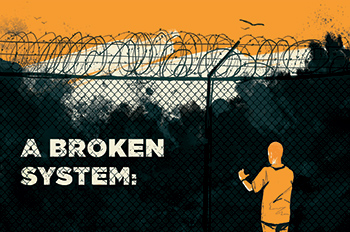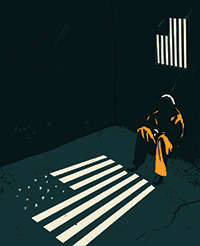A Broken System: Social Work Tackles Criminal Justice Reform
By Alison Laurio

Soon after becoming head of Colorado corrections in 2013, Rick Raemisch started asking why inmates were being housed in solitary confinement. He was appointed to the position, in part, to make changes in its use.
So early in 2014, he went to a state penitentiary, climbed into an inmate uniform, was handcuffed and shackled, and went in what they called Ad Seg (Administrative Segregation) to find out what it was like to be in solitary.
Solitary confinement is just one of many issues the social work profession is tackling as part of criminal justice system reform. From changing the use of cash bail to working in prisons, preparing those in prison and their families for release, and changing research so findings can be implemented faster, social workers are addressing many challenges to improve the system and its outcome.
Solitary Confinement
Raemisch succeeded in accomplishing what he wrote were his directives upon appointment: Eliminate the use of solitary for mentally ill inmates, address those held in solitary for long periods, and reduce the number released directly from solitary into the community. He wrote a 2014 opinion piece in the New York Times about his experience in solitary, and a second in 2017 after dramatic changes had been made to reduce and limit his state’s use of it.
Amy Fettig, deputy director of the National Prison Project at the ACLU, also directs their Stop Solitary Campaign and as an attorney handles cases regarding medical and mental health care in prison, solitary confinement, prison rape, and comprehensive reform in juvenile facilities.
Decades of research on the psychological impact of solitary confinement—much of it based on civil rights litigation as the U.S. ramped up its use to a massive scale—shows it mostly damages people, she said.
“For people with mental illness, it’s even more harmful,” Fettig said. “There’s been a great deal of self-mutilation and suicides. What’s emerging now is research looking at the physical impacts on human beings.”
That includes a 31 percent increase in serious cardiac problems over the lifetime, she said.
“It’s disconcerting. That is way beyond punishment.”

Often used for behavioral problems, it’s not a place where anyone should be for a minor reason, Fettig said. “No other country does that. The United Nations standard is a 15-day limit. That’s the Mandela rule. Anything else is cruel and inhumane.”
Solitary was adopted because it’s easy for prison administration, but people in solitary can become angry and delusional, and violence can rise, she said. Limiting the amount of time a person is in solitary, training staff how to work with people who have mental illnesses, and how to work with kids can help.
The Center for Children’s Law and Policy launched a Stop Solitary for Kids Campaign in 2016 for children under federal jurisdiction, which Fettig said she hopes will provide a national model.
“Last year 28 states introduced legislation. That’s a high water mark.”
“Because social workers are so involved in the criminal justice system as employees, they have a very strong role to play in speaking out on injustice problems,” she said. “They have ideas to create more humane and more effective systems. It would be extremely helpful if NASW took a stand against solitary confinement.”
There are 22 states and D.C. with laws regulating the shackling of pregnant women, another issue Fettig works on. “Unfortunately, some places where they have laws on the books are not following them. It’s really astonishing and puts the mother and fetus at enormous and unnecessary risk, according to the AMA and colleges of gynecology.”
“The role social work can play in changing the criminal justice system is enormous, and as yet untapped,” Fettig said.
Moya Atkinson was executive director of NASW’s Maryland chapter for nearly 10 years before retiring. She co-founded Social Workers Against Solitary Confinement, “an issues chapter of the Social Welfare Action Alliance,” in 2014. After reading an OpEd written by Mary Buser in the April 4, 2014, Washington Post, Atkinson tracked down Buser and the pair established SWASC.
“No social work advocacy group was addressing the cruelty and dehumanization of solitary confinement and social workers’ involvement,” Atkinson said. Solitary is “dehumanizing, torturous treatment” that violates human rights, and can ruin the lives of the incarcerated and their families.
SWASC is networking and provides education, advocacy and mutual support through its listserv, open monthly meetings, and its newsletter—which reaches around 900 people, Atkinson said.
“We have a loose organization of members who include formerly incarcerated, family and friends of incarcerated, and health professionals,” she said. “We have been inviting the social work professional organizations to work with us to end long-term solitary confinement effects on society.”
The group also participated in a workshop with the Social Welfare Action Alliance, she said, and the two organizations are planning a collaborative conference in 2021.
“As SWASC looks forward, it will explore alternatives to the current system, including radical change—abolition of prisons,” Atkinson said.
Cash Bail

“The National Association of Social Workers believes that cash bail policies should be abolished nationwide to promote social justice by addressing gender, racial, ethnic, and socioeconomic disparities. Ending cash bail policies would allow people who are innocent until proven guilty to remain free pretrial. When people fight their cases from the community, rather than jail, they can continue contributing to those communities and avoid the harms caused by incarceration.”
Those words top the beginning of NASW’s social justice issue brief “Abolishing Cash Bail to Promote Social Justice.” It was co-authored by Brandy E. Henry, Brandeis University Heller School for Social Policy & Management; and Mel Wilson, NASW senior policy consultant.
NASW is part of a national coalition that works together around issues of criminal justice reform, and there are many areas where social workers are involved, from the front end of charges and bail to parole and probation, Wilson said. “Probably one of the most important things we do is advocacy to bring about change.”
In the brief, Wilson wrote that pretrial detention is “one of the most impactful factors” in the system as “11 million people are admitted to jails annually” and “on any given day, almost half a million people are awaiting trial in local jails.”
Pretrial detainees comprise about two-thirds of those held in jails, it states, and they have “led to 95 percent of the growth in the jail population nationally over the last 20 years.”
The brief also notes only one other country in the world, the Philippines, continues use of cash bail.
California on Oct. 1, 2019, became the first state to abolish bail for those awaiting trial. After signing the bill into law, Gov. Jerry Brown said, “Today California reforms its bail system so that rich and poor alike are treated fairly.”
Besides California, states that have eliminated commercial bail bondsmen include Illinois, Kentucky, Massachusetts, Oregon and Wisconsin. And some judges and advocates suggest nonprofits could play a part to change the for-profit bail system.
The role of social workers in this can include referral to a community bail fund or defense group and legislative advocacy to end cash bail, the brief states.
Getting Facts Faster
For Carrie Pettus-Davis, cutting the time from research to practice is personal. She writes about why in a note at the beginning of a paper released in May titled “Accelerating Science Using the Research-to-Practice Feedback Loop: Early Findings From A Multi-State Trial.” It relates to her son, who at birth was dubbed “Baby Awesome” by his older sister.
“I am the mother of a five-year old son with autism,” she wrote. “As a researcher, I know that there is—on average—a 17-year gap between science and actual changes to policy and practice in medical and human service fields. So while my colleagues at the Autism Institute innovate every single day and identify increasingly more effective ways to work with kids like Awesome, the therapists who are currently working with him won’t have access to that knowledge for many years to come.”
Pettus-Davis is founding director of the Institute for Justice Research and Development in Tallahassee, Fla., and associate professor at the Florida State University College of Social Work.
She had been founding co-director of the Smart Decarceration Initiative at the Center for Social Development at Washington University’s Brown School. That turned into the American Academy of Social Work and Social Welfare’s Grand Challenge to Promote Smart Decarceration, for which she was co-leader.
The new institute was launched in June 2018 with two employees. Now there are 78.
“What’s most unique about us is we’re committed to rapid translation of findings on policy and practice,” Pettus-Davis said. “The second thing is we’re the largest researcher focusing on criminal justice and bring in multi-disciplinary staff and other scholars.”
The institute website states “We are an innovation lab of ground-breaking virtual, mixed reality, and artificial intelligence technology applications for behavioral interventions, policy simulations and research and training.”
They developed the Research-to-Practice Feedback Loop, where research findings are released in real time. That can mean quarterly reports during the study, not everything at its end years later.
“One of the proposals we have out now is to develop a virtual environment to do trainings with prosecutors,” she said. To promote best practices, that could allow prosecutors to experience being the other person who is interacting with a prosecutor.
The institute also is working with a partner to create a phone app so patients can connect with practitioners when services are needed.
Pettus-Davis believes it is important to focus on the whole system, which she views as working in silos where feeder mechanisms take things from one silo to the next. That, she said, creates the most incarceration and the most disparities in it. An example is a woman of color living in a neighborhood where residents are mainly people of color.
“It’s not her level of criminal behavior,” Pettus-Davis said. “There’s her level of interactions with the police. That disparity makes her more likely to be charged. It’s the same with the economic factors of a community.”
And lower income defendants often rely on public defenders with busy schedules and high caseloads that sometimes can impact the time of action on a case and its outcome, she said.
The institute’s published findings are at on the Institute for Justice Research and Development website.
Mental Health
People can bring a wide range of mental health issues with them when they are sentenced to jail or prison, said Melissa D. Grady, social work associate professor and chair, clinical concentration, at the National Catholic School of Social Service in Washington, D.C.
“It can be everything from substance use disorder to persistent mental health disorders, and a lot have PTSD,” she said. “Research on rates of trauma show it’s quite high compared to the general population.”
“One issue you may see is aggression or violence that may be a manifestation of issues they’ve had in the past. Trauma can affect the brain so a person can’t think clearly or have emotional control or trust.”
Also common are mental health issues associated with trauma, because of the high rates of trauma among the prison population, said Grady, who also is a practice working group co-leader for the Smart Decarceration Grand Challenge for Social Work.
“Many times you don’t know what they entered with,” she said. “They don’t come in with records. There’s an intake, but it’s what they choose to share. For people struggling with substance abuse disorder and addiction, if they don’t have access to those, you could see ups and downs. If they use them for depression or anxiety, you might see more of those symptoms because they don’t have the substances to squash it.”
However, every prison has a hospital ward or physician, and some in prison who have been on prescribed medication might have continued access to it and possibly become more stable, Grady said.
The role social workers play in prisons varies from state to state. Many states are “psychology heavy,” and some state policies require psychologists.
“That’s a problem,” Grady said. “When I was in North Carolina, they did not have job descriptions for social workers but social workers could have done those jobs. In California, social workers are a big part of the workforce.”
More services outside prisons are needed so people can be stable when released, she said. Those can include The Good Life Model, which helps people build healthy and supportive relationships and the Circles of Support program, where members of the community volunteer to be part of a person’s support system.
Also needed are preventions that address issues so people don’t end up incarcerated, Grady said. Those include health and mental health care for everyone, and identifying school children who need help to “create a different trajectory” for them.
Working Inside
When Christine Kregg was an undergraduate, she went into a jail to interview a Latino woman for an agency’s needs assessments.
“Sitting in that holding cell listening to her describe the trauma in her background, I remember feeling ‘if not for my background and race, I could be in her circumstances,’” she said. “It seemed to me that issues of poverty and racism and social injustice were the nucleus of the criminal justice system and how our society treats people. Leaving the jail that day, I wept. She couldn’t leave, but I could. I’ve been doing reform work ever since.”
After her passion for criminal justice was ignited, Kregg worked for a nonprofit human rights organization advocating to end prison rape, doing staff training, and working on policy reform. But she was overwhelmed by the amount of untreated trauma.
“I wanted to do social justice work on a personal level. That inspired me to become a social worker,” she said. “I wanted to become a social worker to be best suited to provide clinical services in a trauma-informed manner. You never practice in a vacuum.”
Now Kregg is a clinical social worker at a medium-custody men’s state prison in California. She said she is not speaking on behalf of her employer, the California Department of Corrections and Rehabilitation.
Kregg has a caseload of about 70 patients, typically seeing six to 15 a day depending on whether she has group therapy. She provides mental health clinical diagnoses and treatment, working a 10-hour shift during which she spends about nine hours with direct patient care.
“Prison environments are inherently dynamic, so 99.9 percent of my patients lives I have no control over,” Kregg said. “Most aspects of their lives are not in their control.”
Many have mental illness. Despair is pervasive, as is hopelessness, she said.
“How can social workers advocate effectively in a space of mountainous barriers to peoples’ well-being? It’s a struggle every day for people behind bars,” she said. “You’re a witness to that, and it’s our job to support them.”
“It’s a monumental task to support people’s dignity, self-worth and self-determination in an environment very contrary to that,” Kregg said. “There are programs supporting rehabilitation, religious services, a library, self-help groups and vocational opportunities. Even so, these challenges remain. They are enormous.”
“I wish all social workers saw the interconnectedness of the system,” she said. “Everything we do outside of the bars is part of what we’re doing here. I think we need more social workers to see it that way—as part of their work. If they are working with children, there are so many pathways to prison that we need to be working on to prevent people from getting here.”
Resources
Brief on Solitary Confinement: A Clinical Social Work Perspective
Smart Decarceration Initiative - Brown School Center for Social Development. Washington University in St. Louis
My Night in Solitary - Opinion article by Rick Raemisch, Feb. 20, 2014
Why We Ended Long-Term Solitary Confinement in Colorado - Opinion article by Rick Raemisch, Oct. 12, 2017
The New Dynamics of Mass Incarceration — Vera Institute of Justice
FAQ: Solitary Confinement in the United States — Solitary Watch
Institute for Justice Research and Development publications on re-entry